An Investigation of Laboratory and Road Test of Common Rail Injection Vehicles Fueled with B20 Biodiesel
Abstract
1. Introduction
2. Materials and Methods
2.1. Tested Fuel
2.2. Tested Vehicle
2.3. Testing Facilities
3. Results
3.1. Emissions Test Result
3.2. Fuel Economy
3.3. Power
3.4. Effect on Engine Components
4. Discussion
5. Conclusions
- B20 emissions, as far as the entire distance traveled, had an average of around 30% lower carbon monoxide (CO) and total hydrocarbon (THC) emissions compared to B0 due to the fuel’s higher oxygen content and cetane number. A trade-off between particulates and NOx could be seen for distances traveled up to 10,000 km in which particulates of B20 were lower than B0; however, the NOx level was higher for B20. Although the difference in NOx and particulate values was small for B20 and B0, this abnormal trade-off trend between NOx and particulate values requires further investigation.
- The fuel economy of vehicles using B20, showing an average of 0.5%, was slightly higher than that of vehicles using B0, which could be considered as being due to the slightly lower calorific value of the B20 blend.
- The maximum power of B20 was lower, around 3%, than vehicles using B0, which could be due to the lower heating value of B20. However, maximum power until medium speed was comparable between B0 and B20.
- The long-term effect after vehicles reached a distance traveled of 40,000 km reveals that engine components, including piston thrust, piston top, liner, cylinder head, bearing, injector, inlet valve and oil sump, had no significant differences for both B20 and B0 between the condition of the engine at the beginning and the end of the test.
Author Contributions
Funding
Acknowledgments
Conflicts of Interest
References
- Wahyono, Y.; Hadiyanto, M.; Budihardjo, A.; Joni, S.A. Assessing the environmental performance of palm oil biodiesel production in Indonesia: A life cycle Assessment approach. Energies 2020, 13, 3248. [Google Scholar] [CrossRef]
- Paryanto, I.; Prakoso, T.; Susanto, B.H.; Ghozin, M. The effect of outdoor temperature conditions and Monoglyceride content on the precipitate formation of biodiesel-petrodiesel blended fuel (Bxx). J. Nov. Carbon Resour. Sci. Green Asia Strategy 2019, 6, 59–64. [Google Scholar] [CrossRef]
- Bannister, D.D.; Hawley, J.G.; Ali, H.M.; Cuck, C.J.; Price, P.; Chrysafi, S.S.; Brown, A.; Pickford, W. The impact of biodiesel blend ratio on vehicle performance and emissions. Proc. IMECHE 2009, 224, 405–421. [Google Scholar] [CrossRef]
- Nitin, M.S.; Pankaj, S.S.; Subhash, L. Experimental investigation of effect of exhaust gas recirculation and cottonseed B20 biodiesel fuel on diesel engine. Procedia Technol. 2016, 25, 869–876. [Google Scholar] [CrossRef]
- Thomas, D.D.; John, R.; Collin, J.N.; Mattew, R.S. Effects of Biodiesel, Biodiesel Blends, and a Synthetic Diesel on Emissions from Light Heavy-Duty Diesel Vehicles. Environ. Sci. Technol. 2000, 34, 349–355. [Google Scholar]
- Rakopoulos, C.D.; Antonopoulos, K.A.; Rakopoulos, D.C.; Hountalas, D.T.; Giakoumis, E.G. Comparative performance and emissions study of a direct injection diesel engine using blends of diesel fuel with vegetable oil or biodiesel of various origin. Energy Convers. Manag. 2006, 47, 3272–3287. [Google Scholar] [CrossRef]
- Robert, L.; Mcmormick, M.G.; Alleman, T.; Rew, M. Herring, Impact of Biodiesel Source Material and Chemical Structure onEmissions of Criteria Pollutants froma Heavy-Duty Engine, Environ. Sci. Technol. 2001, 35, 1742–1747. [Google Scholar] [CrossRef]
- Wang, W.G.; Lyons, D.W.; Clark, N.N.M. Gautam, Emissions from Nine Heavy TrucksFueled by Diesel and Biodiesel Blend without Engine Modification. Environ. Sci. Technol. 2000, 34, 933–939. [Google Scholar] [CrossRef]
- Robert, L.M.; Christopher, J.T.; Hayes, R.R.; Black, S.; Ireland, J.; McDaniel, T.; Williams, A.; Frailey, M.; Christopher, A.S. Regulated Emissions from Biodiesel Tested in Heavy-Duty Engines Meeting 2004 Emission Standards; SAE: Warrendale, PA, USA, 2005. [Google Scholar] [CrossRef]
- Manjunath, C.; Ramesh, K.; Manavendra, G. Comparative study of standard engine and modified engine with different piston bowl geometries operated with B20 fuel blend. Renew. Energy 2019, 133, 216–232. [Google Scholar] [CrossRef]
- Thompson, G.J.; Nuszkowski, J. Neat fuel influence on biodiesel blend emissions. Int. J. Engine Res. 2009, 11, 61–77. [Google Scholar] [CrossRef]
- Anand, K.; Sharma, R.P.; Mehta, P.S. Experimental investigations on combustion, performance, and emissions characteristics of a neat biodiesel-fuelled, turbo charged, direct injection diesel engine, Proceedings of the Institution of Mechanical Engineers, Part D. J. Automob. Eng. 2010, 224. [Google Scholar] [CrossRef]
- Lammert, M.; Barnitt, R.; McCormick, R.L. Field Evaluation of Biodiesel (B20) use by Transit Buses. SAE Int. J. Commer.Veh. 2009, 2, 209–221. [Google Scholar] [CrossRef][Green Version]
- Wadumesthrige, K.; Johnson, N.; Winston-Galant, M.; Tang, H.; Simon Ng, K.Y.; Salley, S.O. Deterioration of B20 from Compression Ignition Engine Operation. SAE Int. J. Fuels Lubr. 2010, 3, 638–648. [Google Scholar] [CrossRef]
- Bartoli, Y.; Edward, J.L.P.; John, E.; Lucke, I.A.K.; Feist, M.D.; McCormick, R.L. 1000-hour Durability Evaluation of a Prototype 2007 Diesel Engine with Aftertreatment Using B20 Biodiesel Fuel. SAE Int. J. Fuels Lubr. 2009, 2, 290–304. [Google Scholar] [CrossRef]
- Galle, J.; Verhels, S.; Sierens, R.; Goyos, L.; Castaneda, R.; Verhaege, M.; Vervaeke, L.; Bastian, M. Failure of fuel injectors in a medium speed diesel engine operating on bio oil. Biomass Bioenergy 2012, 40, 27–35. [Google Scholar] [CrossRef]
- Chen, Y.; Jens, B.K. NOx emissions from diesel passenger cars worsen with age. Environ. Sci. Technol. 2016, 50, 3327–3332. [Google Scholar] [CrossRef] [PubMed]
- Deep, A.; Sarbjot, S.S.; Chander, S. Experimental investigation on the influence of fuel injection timing and pressure on single cylinder C.I engine fueled with 20% blend of castor biodiesel in diesel. Fuel 2010, 15–22. [Google Scholar] [CrossRef]
- Abed, K.A.; Gad, M.S.; El Morsi, A.K.; Sayed, M.M.; Elyazeed, A.A. Effect of biodiesel fuels on diesel engine emissions. Egypt. J. Pet. 2019, 28, 183–188. [Google Scholar] [CrossRef]
- Liaquat, A.M.; Masjuki, H.H.; Kalam, M.A.; Fazal, M.A.; Khan, A.F.; Fayaz, H.; Varman, M. Impact of palm biodiesel blend on injector deposit formation. Appl. Energy 2013, 111, 882–893. [Google Scholar] [CrossRef]
- Luqman, R.; Shahid, I.; Zahid, A.M.; Farooq, M.M.; Abbas, H.M.; Khan, T.A.M.; Amjad, M.E.M.; Soudagar, N.S.; Fattah, I.M.R.; Rahman, S.M.A. Maximising yield and engine efficiency using optimized waste cooking oil biodiesel. Energies 2020, 13, 5941. [Google Scholar] [CrossRef]
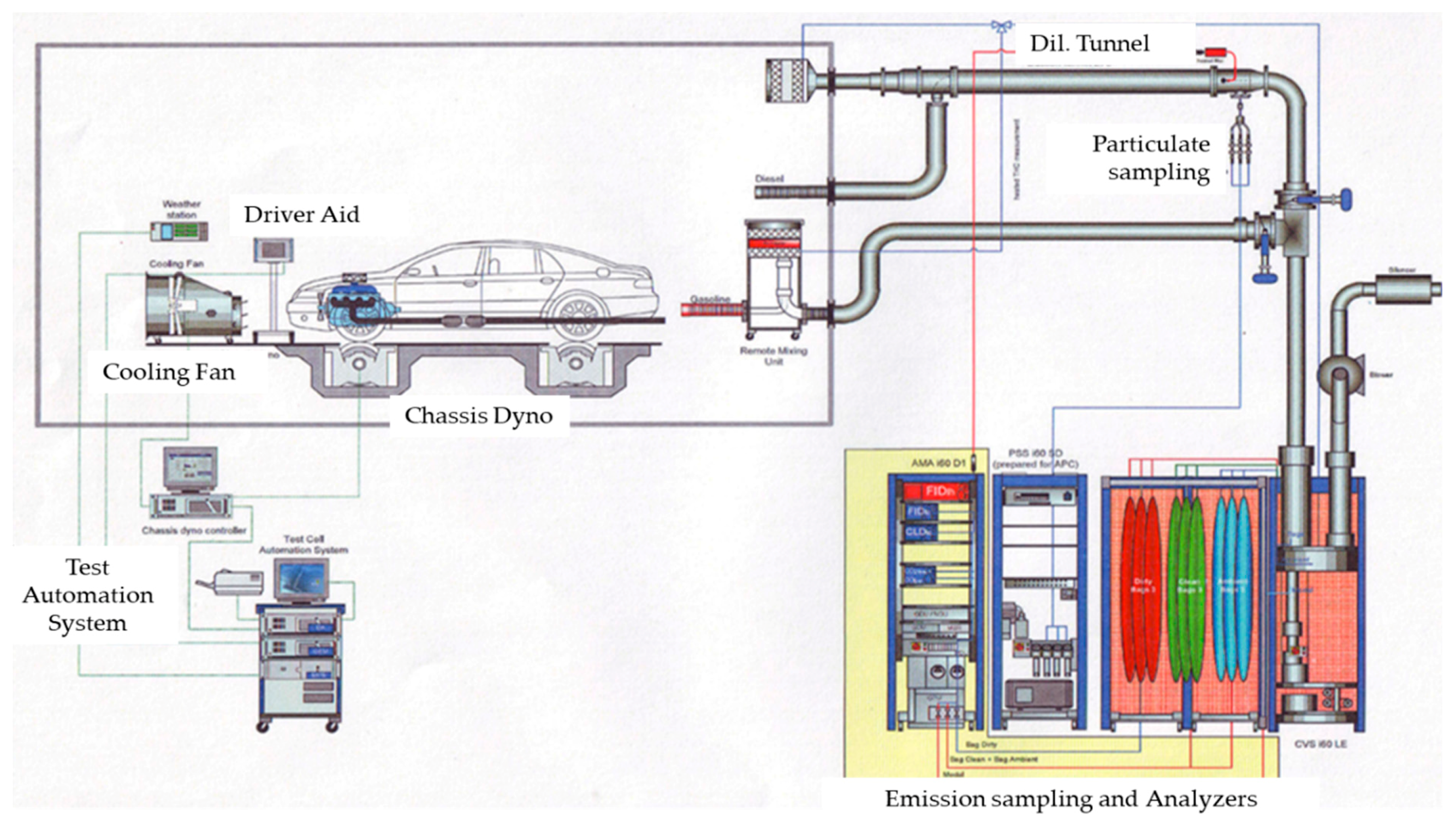

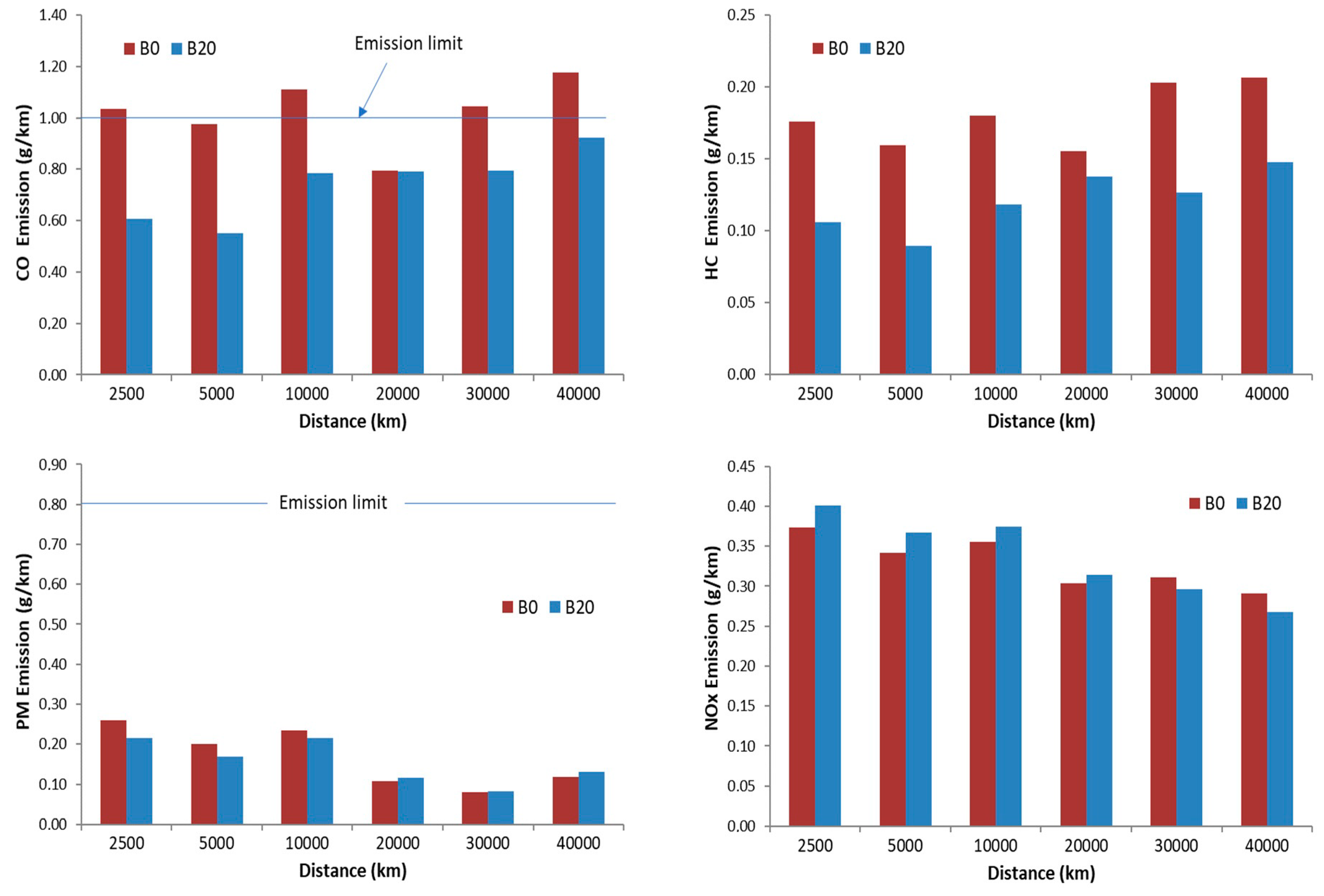

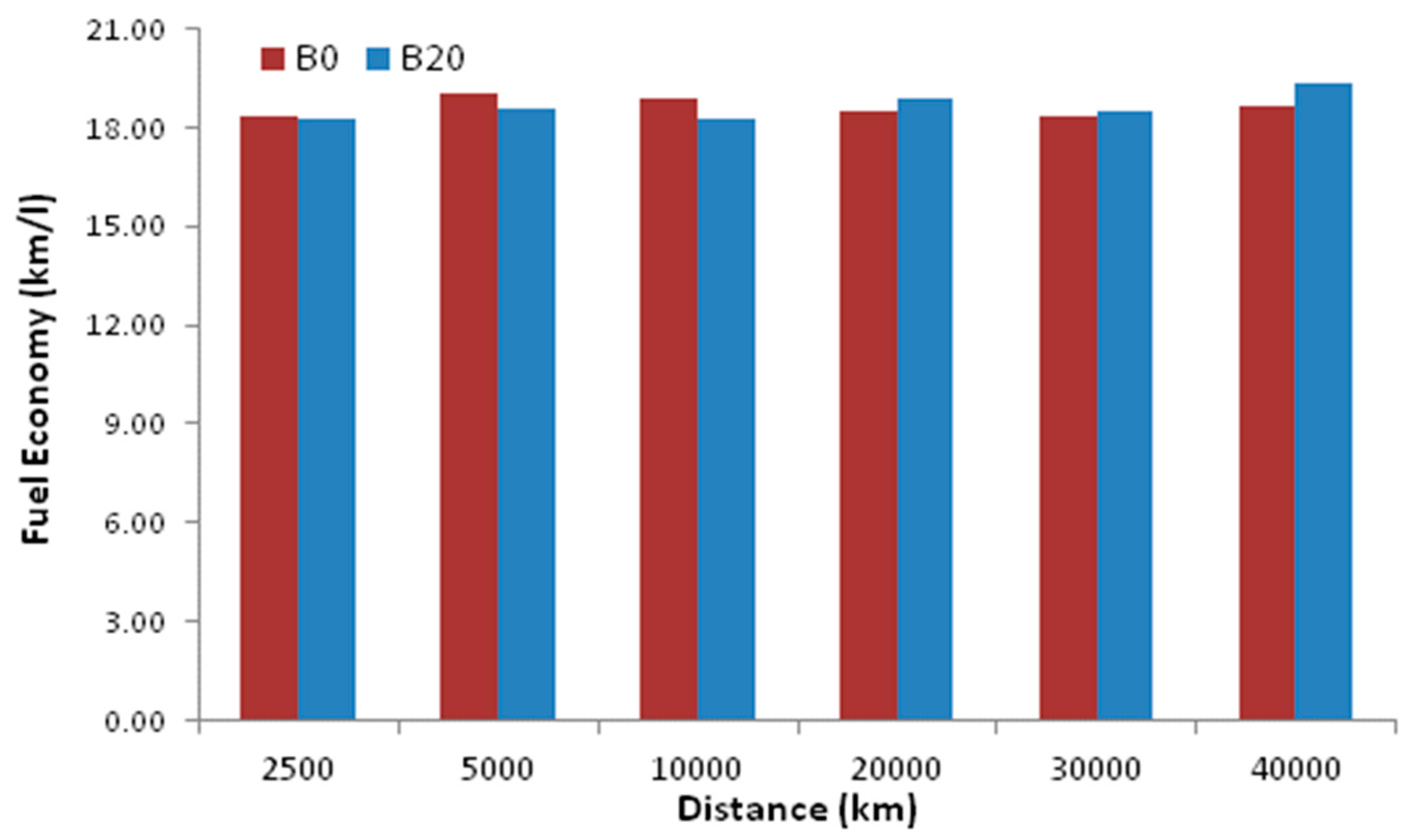

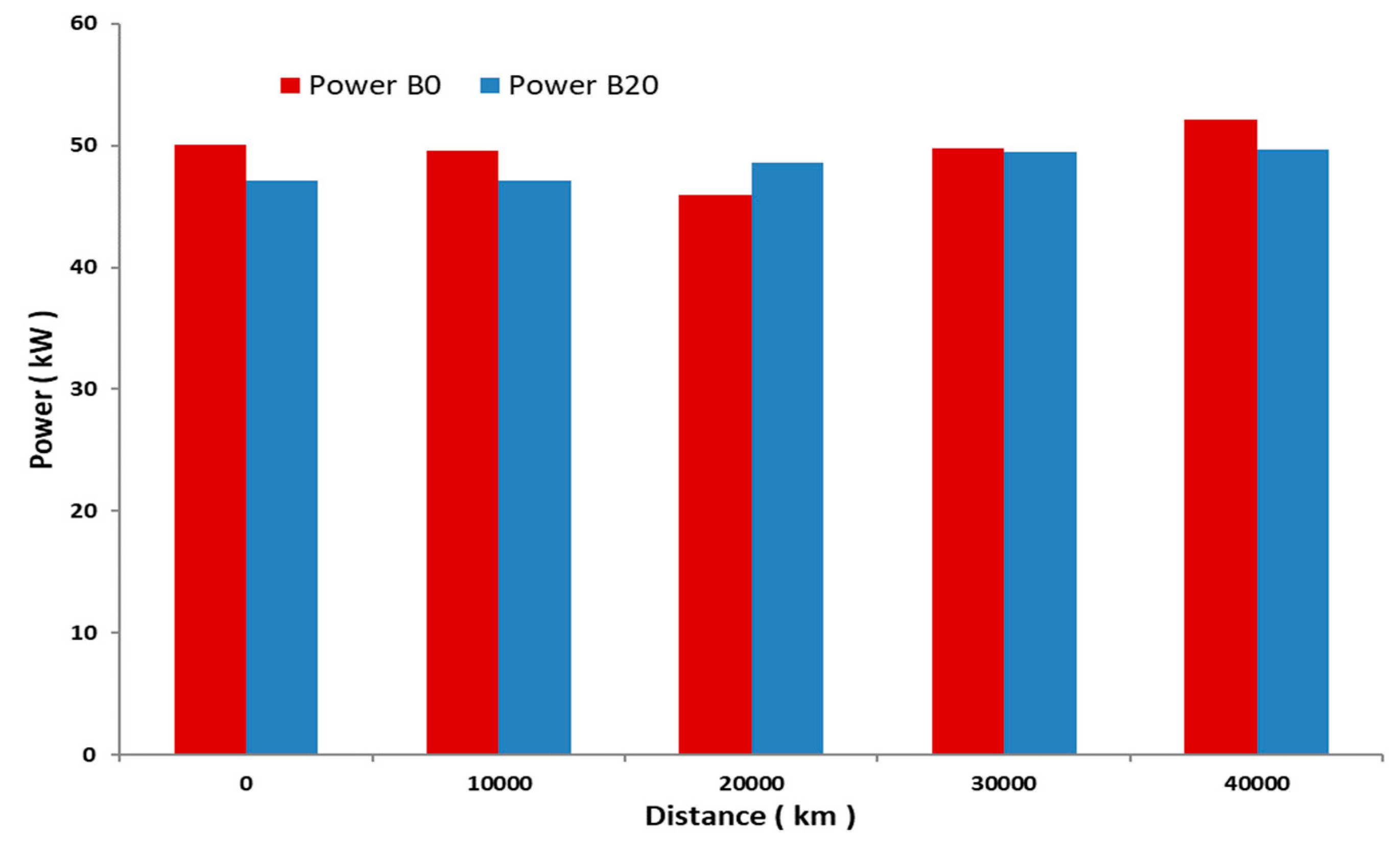
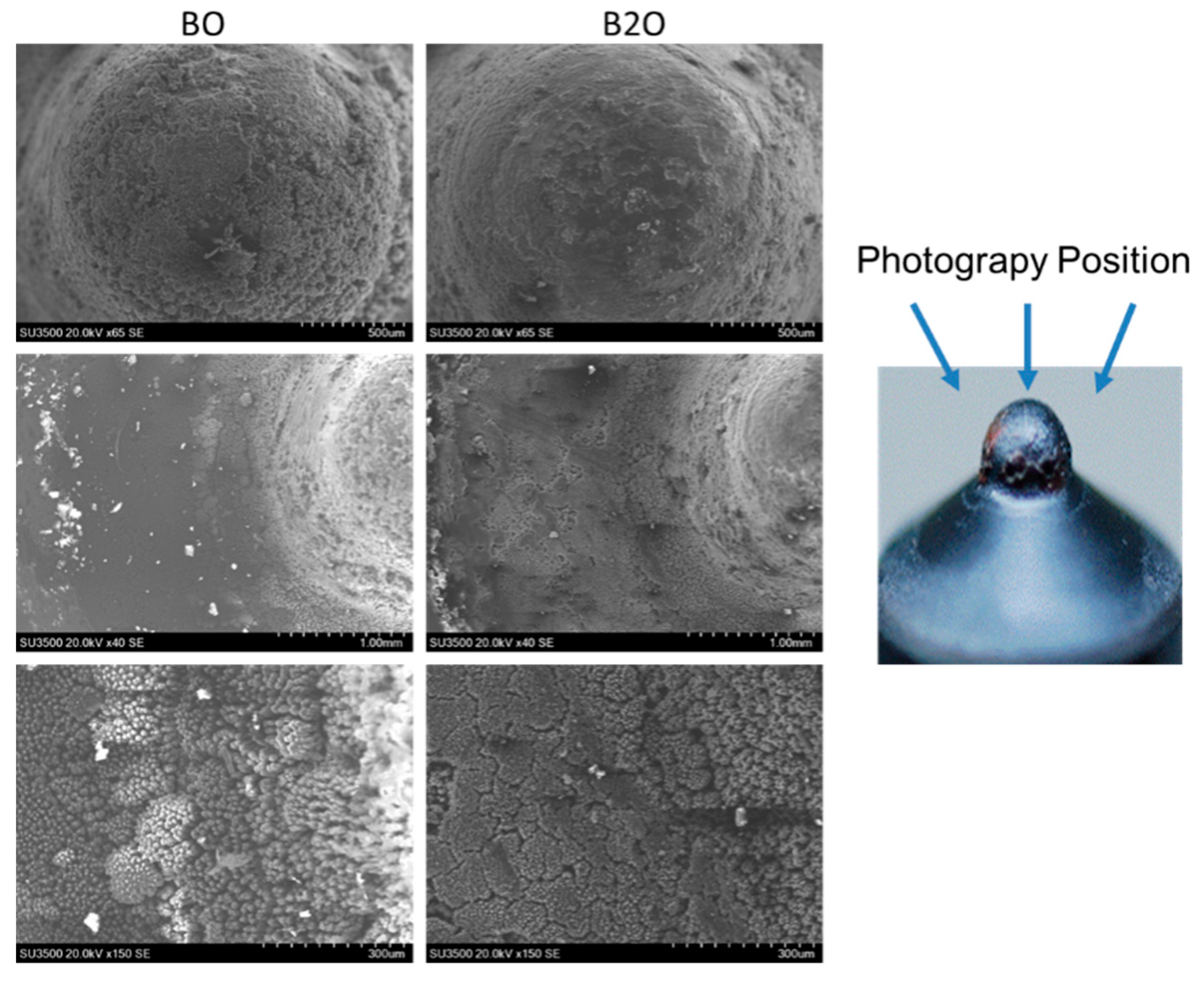
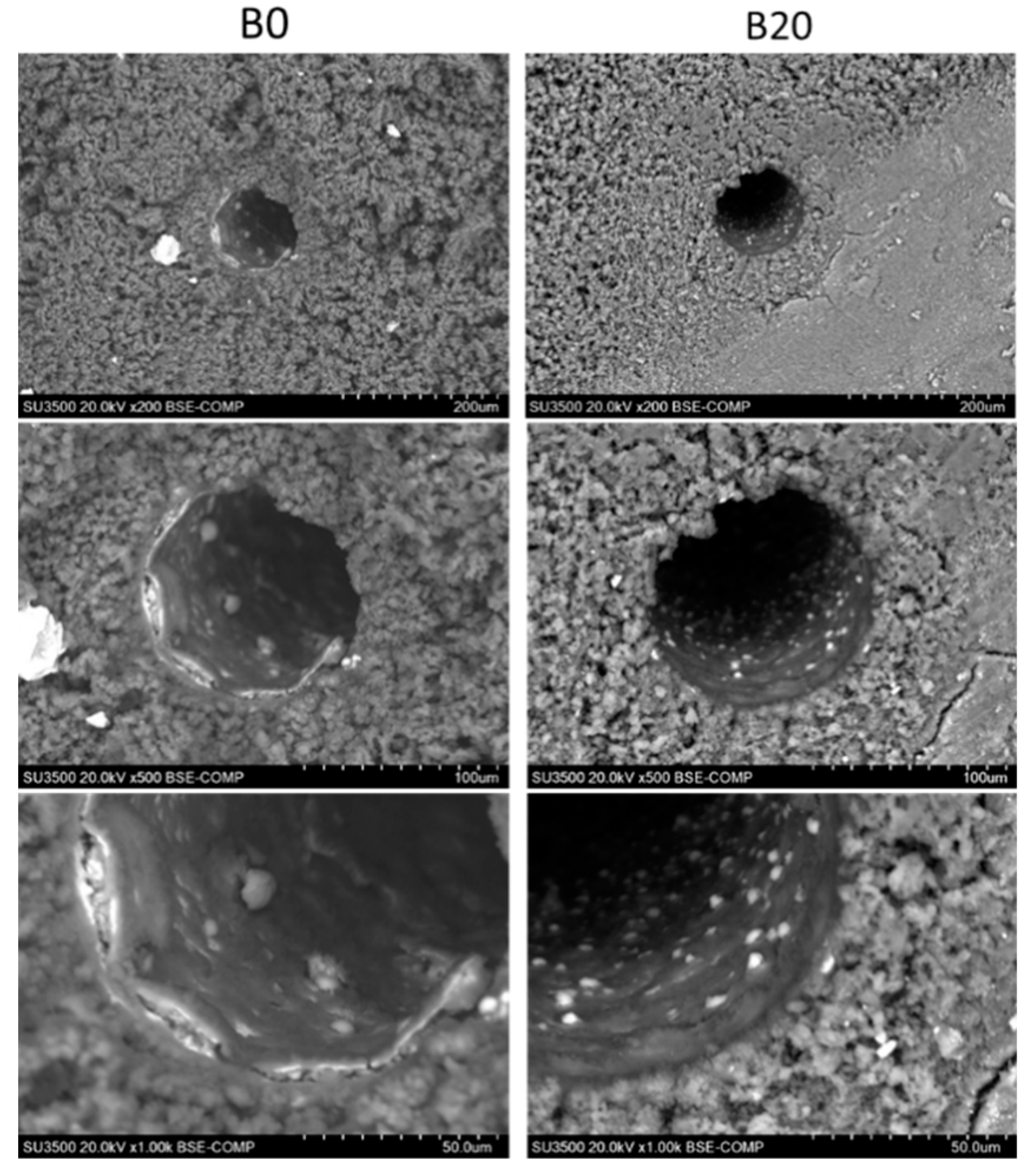
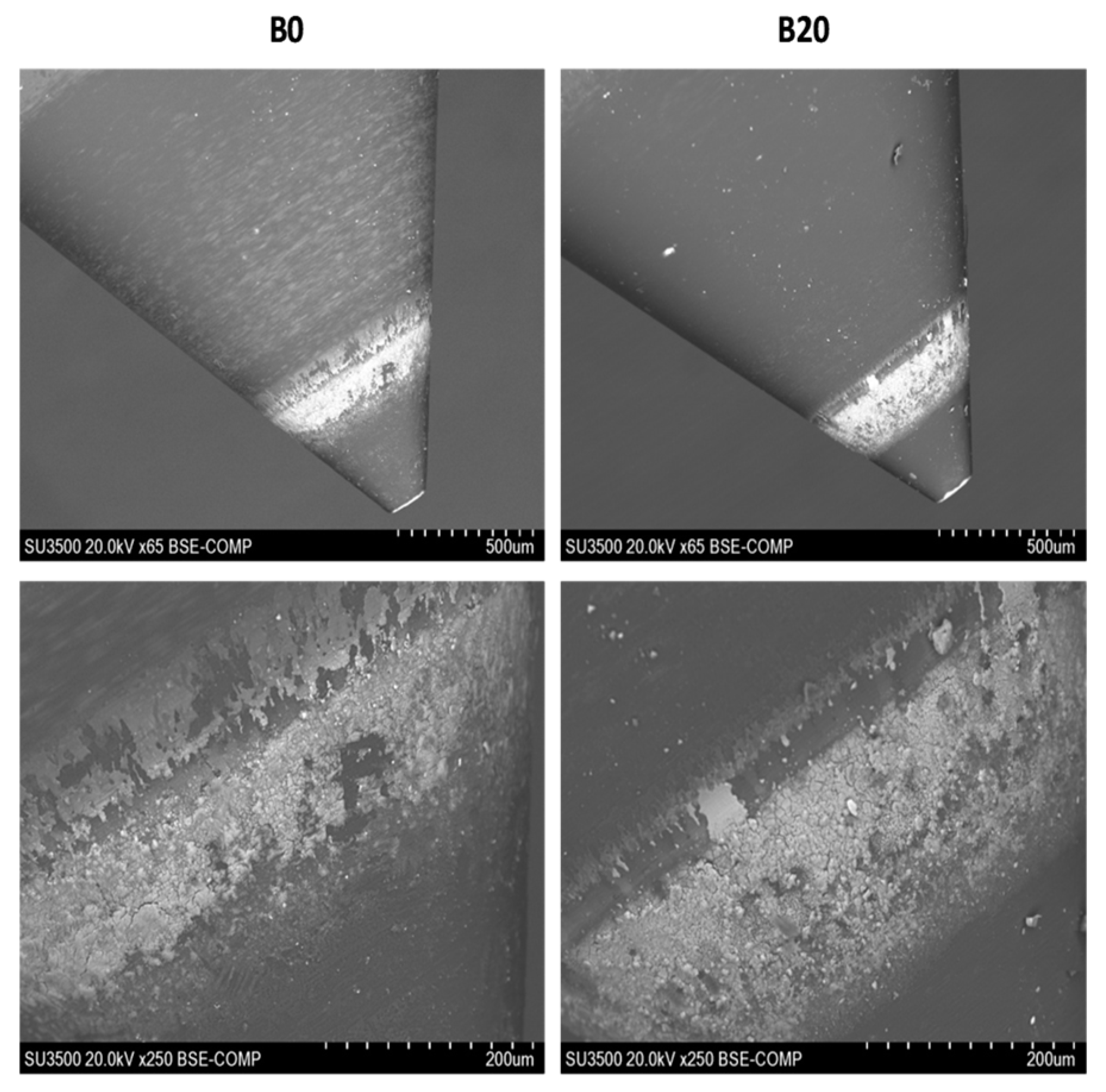
| No. | Parameters | Unit | Method ASTM | Fuel | |
|---|---|---|---|---|---|
| B0 | B20 | ||||
| 1 | Cetane Number | - | D613 | 48.8 | 49.3 |
| 2 | Index Cetane | - | D4737 | 46.6 | 47.1 |
| 3 | Density at 15 °C | kg/m3 | D4052 | 851.8 | 855 |
| 4 | Viscosity at 40 °C | mm2/s | D445 | 3.15 | 3.56 |
| 5 | Sulfur Content | ppm | D2622 | 790 | 680 |
| 6 | Distillation point (90% vol.) | °C | D1160 | 348 | 354 |
| 7 | Flash Point | °C | D93 | 62 | 67 |
| 8 | Pour Point | °C | D97 | −3 | −3 |
| 9 | Carbon Residue | % m/m | D4530 | nil | nil |
| 10 | Water Content | mg/kg | D1744 | 205 | 479 |
| 11 | Oxidation Stability | minutes | EN15751 | >200 | 105.87 |
| 12 | Biological Growth | - | nil | nil | |
| 13 | FAME Content | % v/v | - | 20 | |
| 14 | Cu Strip Corrosion | merit | D130 | 1A | 1A |
| 15 | Ash Content | % m/m | D482 | nil | 0.002 |
| 16 | Sediment Content | % m/m | D4737 | nil | nil |
| 17 | Total Acid Number | mg KOH/g | D664 | 0.045 | 0.103 |
| 18 | Lubricity (HFRR scar wear diameter @60 °C) | micron | D6079 | 353 | 288 |
| 19 | Visual | - | - | Clear & Bright | Clear & Bright |
| 20 | Color | D1500 | 1.5 | 1.5 | |
| No. | Item | Specification |
|---|---|---|
| 1 | Engine Displacement (cc) | 1248 |
| 2 | Maximum Power Output (PS/rpm) | 75/4000 |
| 3 | Maximum Torque (Nm/rpm) | 190/1750 |
| 4 | Number of Cylinders | 4 |
| 5 | Valve System | In-line 16 valve DOHC |
| 6 | Intake System | Turbo Charger with Intercooler and EGR |
| 7 | Fuel Supply | Common Rail Injection Systems |
| 8 | Vehicle Emission Category | Euro2 |
| B0 Fuel | B20 Fuel | Remark |
|---|---|---|
| Piston thrust | No significant difference observed | |
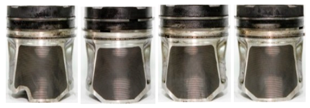 | 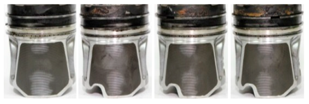 | |
| There was a thin carbon deposit under 2nd ring and no carbon under oil ring. Wear not found significantly, either on the pistons or the cylinder wall. | There was a thin carbon deposit under 2nd ring and no carbon under oil ring. Wear not found significantly, either on the pistons or the cylinder wall. | |
| Piston top | No significant difference observed | |
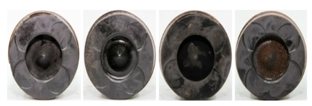 | 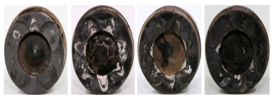 | |
| Deposit was formed in piston bowl and categorized as a medium deposit | Deposit was formed in piston bowl and categorized as a medium deposit | |
| Cylinder head | No significant difference observed | |
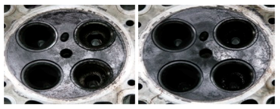 |  | |
| Medium level deposit formed | Medium level deposit formed | |
| Bearing | Shape and level of damage/ scratches were similar for B0 and B20 | |
 | 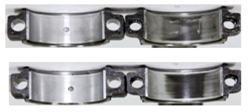 | |
| Light scratch was found at big end of bearing (upper) for all cylinders | Light scratch was found at big end of bearings (upper) for all cylinders | |
| Oil Tank | Sludge formed at the oil sump is similar in amounts | |
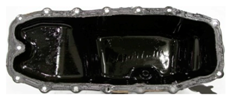 |  | |
| Sludge at oil sump was very small | Sludge at oil sump was very small | |
Publisher’s Note: MDPI stays neutral with regard to jurisdictional claims in published maps and institutional affiliations. |
© 2020 by the authors. Licensee MDPI, Basel, Switzerland. This article is an open access article distributed under the terms and conditions of the Creative Commons Attribution (CC BY) license (http://creativecommons.org/licenses/by/4.0/).
Share and Cite
Reksowardojo, I.K.; Setiapraja, H.; Fajar, R.; Wibowo, E.; Kusdiana, D. An Investigation of Laboratory and Road Test of Common Rail Injection Vehicles Fueled with B20 Biodiesel. Energies 2020, 13, 6118. https://doi.org/10.3390/en13226118
Reksowardojo IK, Setiapraja H, Fajar R, Wibowo E, Kusdiana D. An Investigation of Laboratory and Road Test of Common Rail Injection Vehicles Fueled with B20 Biodiesel. Energies. 2020; 13(22):6118. https://doi.org/10.3390/en13226118
Chicago/Turabian StyleReksowardojo, Iman K., Hari Setiapraja, Rizqon Fajar, Edi Wibowo, and Dadan Kusdiana. 2020. "An Investigation of Laboratory and Road Test of Common Rail Injection Vehicles Fueled with B20 Biodiesel" Energies 13, no. 22: 6118. https://doi.org/10.3390/en13226118
APA StyleReksowardojo, I. K., Setiapraja, H., Fajar, R., Wibowo, E., & Kusdiana, D. (2020). An Investigation of Laboratory and Road Test of Common Rail Injection Vehicles Fueled with B20 Biodiesel. Energies, 13(22), 6118. https://doi.org/10.3390/en13226118





